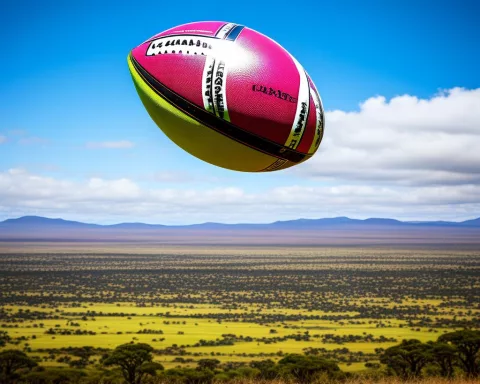Louis Rees-Zammit is making a surprising career change from rugby to American football, and former rugby and NFL player Naas Botha offers valuable insights on the transition. Botha advises Rees-Zammit to determine his position on the field, adjust to the physicality of American football, and adapt to the NFL atmosphere without the standard four-year collegiate journey. Rees-Zammit’s international rugby background may prove useful, but he also needs a comprehensive transformation in his approach and mindset to succeed. Botha expresses excitement and eagerness for Rees-Zammit’s NFL journey, as this remarkable move is an impressive example of sports transcending boundaries.
How can Louis Rees-Zammit succeed in transitioning from rugby to American football?
Botha suggests that Rees-Zammit needs to determine his position on the field, adjust to American football’s physicality, and adapt to the NFL atmosphere without the benefit of a typical four-year university college cycle. Rees-Zammit’s international rugby background may prove useful, but he also needs a comprehensive transformation in his approach and mindset to succeed.
In our present era marked by athletes continuously pushing their skills to the limits and questioning traditional sports frameworks, an intriguing development has come to light. Louis Rees-Zammit, a rising talent from Wales who was making waves in the rugby world, has recently declared his intent to shift into American football. This announcement has attracted attention from various sectors, notably Naas Botha, a famed personality in South African rugby lore. Recognized for his own shift from rugby to American football, Botha’s perspectives on this surprising career change add a richness to the story.
A Historical Overview: Naas Botha’s Career Shift
Naas Botha, whose name remains a fixture in rugby’s historical record, is also remembered for his venture into American football in the early 1980s. His shining rugby career took a surprising twist when he joined a trial with the Dallas Cowboys, resulting in an extraordinary crossover. This move saw him, as a celebrated Springbok player, immersing himself in the world of gridiron. Even though his tenure with the NFL was brief, Botha’s journey continues to be an iconic segment in sports history.
Fast forward to the present day, the newest entrant in the NFL International Pathway Program is none other than Louis Rees-Zammit. Reflecting on his own experiences, Botha offered his insights about Rees-Zammit’s shift. He praised the Welsh rugby player’s talents and highlighted the need for precision in navigating the vast disparities between rugby and American football.
Valuable Insights from Botha
Botha suggested that Rees-Zammit’s triumph would hinge on his grasp of American football’s nuances. “Firstly, he needs to determine his position in the field,” Botha advised. Depending on the chosen position, Rees-Zammit would need to adjust to the game’s physicality, which could pose a substantial challenge.
Discussing the necessary adjustments and challenges, Botha emphasized the lack of a typical four-year university college cycle in Rees-Zammit’s transition. Unlike the standard collegiate journey most American football players undertake, Rees-Zammit would have to depend on his inherent skills and adaptability to thrive in the demanding NFL atmosphere. However, Botha remained hopeful, noting that Rees-Zammit’s international rugby background could be a useful resource in this new endeavor.
In words of encouragement, Botha applauded Rees-Zammit’s choice. “You must have a deep passion if you want to pursue that,” he remarked, expressing faith in the Welsh player’s capacity to adapt swiftly due to his commitment and work ethic. Botha also underscored the pronounced difference between the two sports, referring to his own stint at an NFL training camp, which exposed him to the stringent standards and uncompromising nature of professional football.
Looking Toward the Future: Botha’s Expectations
Looking forward, Botha emphasized the requirement for a mental shift in the game, underlining a fundamental difference between rugby and American football – players in the NFL can experience significant hits without possession of the ball. This observation implies that Rees-Zammit’s success will demand a comprehensive transformation in his approach and mindset, beyond his obvious physical capabilities.
As Botha observes Rees-Zammit’s entry into the NFL, he expressed excitement and eagerness. Observing the unique attributes that Rees-Zammit brings from rugby, he also recognized the unique trials of American football. This remarkable move has elicited fascination within the sports community, and everyone is eagerly awaiting the performance of this young Welsh star on American football’s grandest stage. This is truly an impressive example of sports transcending boundaries, fostering a sense of worldwide anticipation and unity.
- What is Louis Rees-Zammit’s career change and why is it surprising?
Louis Rees-Zammit is making a surprising career change from rugby to American football.
- Who is Naas Botha and how does he relate to Rees-Zammit’s career change?
Naas Botha is a former rugby and NFL player who offers valuable insights on the transition from rugby to American football. Botha advised Rees-Zammit to determine his position on the field, adjust to the physicality of American football, and adapt to the NFL atmosphere without the standard four-year collegiate journey.
- What advice did Botha give Rees-Zammit?
Botha suggested that Rees-Zammit needs to determine his position on the field, adjust to American football’s physicality, and adapt to the NFL atmosphere without the benefit of a typical four-year university college cycle.
- How might Rees-Zammit’s international rugby background be useful in his transition to American football?
Rees-Zammit’s international rugby background may prove useful, but he also needs a comprehensive transformation in his approach and mindset to succeed.
- What did Botha emphasize about the difference between rugby and American football?
Botha emphasized the requirement for a mental shift in the game, underlining a fundamental difference between rugby and American football – players in the NFL can experience significant hits without possession of the ball.
- What are Botha’s expectations for Rees-Zammit’s performance in the NFL?
Botha expressed excitement and eagerness for Rees-Zammit’s NFL journey, as this remarkable move is an impressive example of sports transcending boundaries.












